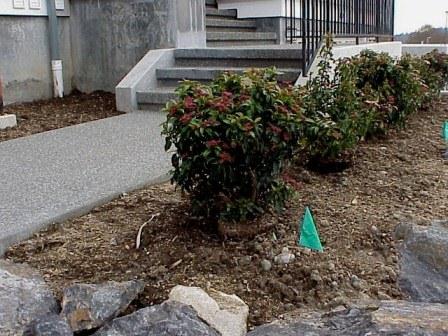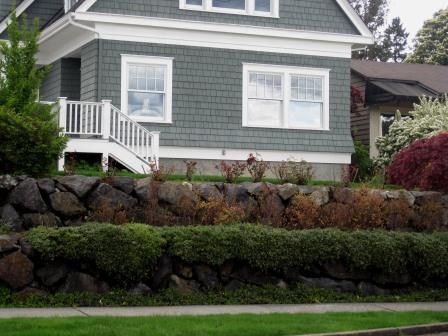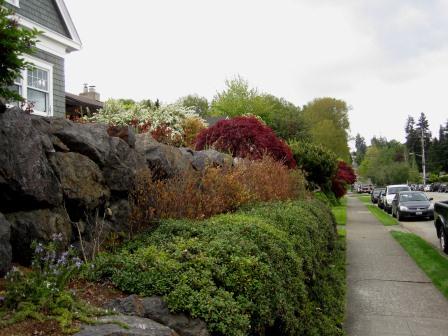One of the planting practices that severely vexes me is the Pop-n-Drop (TM) method, where plants are popped out of the container and dropped into a hole roughly the same size. When I’m lucky enough to find such installations in progress, I try to take as many photos as possible for later comparisons. Here’s one such landscape that was installed in this manner:

A row of Pop-n-Drops in 2002
And here’s the same landscape 10 years later:

Two rows of Pop-n-Drops in 2012
Some of the shrubs survived, some did not, and certainly none of them are thriving. You can see that the shrubs have remained about the same height after a decade of “growth.” Yet this practice continues to be SOP for many landscaping companies all in the name of shaving off a few minutes of labor and making a few more $$.
We GPs can (and do!) disagree about how much root preparation is needed before planting containerized and B&B trees and shrubs. But I don’t think any of us would recommend NO root preparation.
(Additional note: the “before” photo is the side of the landscape that faces west. Those shrubs are gone. The “after” photo is facing south (this is a corner lot). All of the landscapes were put in at the same time, in the same fashion. Unfortunately I didn’t take photos of the south facing landscape when it was put in, and the one that failed on the west was replaced before I knew it had died. Sorry for not including this explanation initially.)
And here is the 2012 landscape from a closer viewpoint; note the dead shrub on the left end of the lower row. The others are all failing, in both this row and the upper row:

Linda,
I always find before and after pictures hugely helpful, but these look bogus and (in my opinion) undermine your argument as a result. The steps are going a different direction in the after, the porch and railing are made of different materials in the after, and the downspout’s in a different place in the after. Is this a different part of the same landscape or have they made MAJOR changes over the last few years or…? I don’t argue your point about root prep being beneficial, but these pictures don’t look like a before and after.
I too am having trouble reconciling the pics
Do you have a different set of pictures to use? I get your explanation, even about the plantings being on different sides of the building, but they don’t even look like the same type of bush? So I can’t see what you’re trying to show me.
Paul and Wes, I’ve added a clarification to the post. Hope that helps. @K, I don’t have any other photos
, but really the species of shrubs aren’t important. What’s important is that none of them, regardless of species, has done well. (The trees and groundcovers are not part of this discussion.)
“Landscapers” like those who plant using this method are one reason Landscapers like me cannot land jobs due to higher labor costs. Most people want their landscape installation done the cheapest not the best way sad to say. Faster to prune shrubs with a motor than by hand too and it shows.
Makes more sense now. Thanks 🙂
Hmm. So is this really all that bad?
Here’s some instructions from a local nursery, where they instruct people to not tease the roots:
http://www.bowpointnursery.com/proper-planting-care/
Also, isn’t there research that supports the problem of heterogeneous soil interfaces preventing plant roots from spreading, thus they recommend that as little soil from the ground be disturbed, so that the roots are forced to grow into the native soil?
Maybe you care to elaborate on what method of root prep you prefer? Perhaps your article could have used a link or two…
Adam, use the search function link in the upper right hand corner. There are several previous posts on the blog on root washing, bare-rooting, etc.